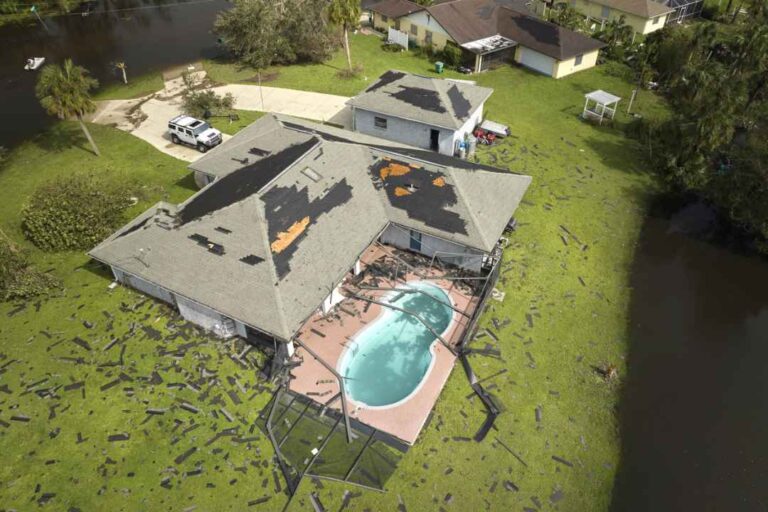The Silent Threat – When Gutters Fail in Chicagoland, Gutter Damage
The Silent Threat – When Gutters Fail in Chicagoland
Your home’s gutter system is often taken for granted, quietly performing its crucial duty of channeling rainwater and melting snow away from your foundation. But after a brutal Illinois winter filled with ice, or a fierce Chicagoland windstorm, you might notice something unsettling: your gutters are no longer straight and snug against your fascia. Instead, they appear to be sagging, bent, or even pulling away from your house, signs of gutter damage
This isn’t just a cosmetic flaw; sagging or detached gutters are a critical warning sign that your home’s water management system is failing, leaving your most valuable asset vulnerable to a cascade of expensive and insidious water damage. Ignoring these signs can lead to foundation cracks, basement flooding, siding rot, and compromised landscaping – problems far more costly than a gutter repair.
At Seidel Exterior Group, we’ve been expertly installing, repairing, and replacing gutters for Chicagoland homeowners since 1970. We understand the specific stresses our local climate places on gutter systems – from the immense weight of ice and snow to the sheer force of high winds. This article will detail the unmistakable signs of gutter damage caused by wind and ice, explain why immediate action is essential, and guide you on when to call in the professionals to protect your home.
Why Sagging Gutters Are a Major Problem for Your Chicagoland Home
When your gutters sag or pull away, they lose their ability to properly collect and direct water. This leads to water being mismanaged around your home, causing a host of significant issues:
- Foundation Damage: This is the most severe and costly consequence. Water overflowing from sagging gutters pours directly onto the soil around your foundation. Over time, this consistent saturation can lead to:
- Hydrostatic Pressure: Water builds up against foundation walls, creating immense pressure that can cause cracks, bowing, or shifting.
- Settling: Uneven soil saturation can lead to parts of your foundation sinking, causing structural problems throughout your home.
- Basement and Crawl Space Flooding: If water pools around your foundation, it will inevitably find its way into your basement or crawl space through cracks, window wells, or even porous concrete. This leads to:
- Water damage to personal belongings.
- Rapid mold and mildew growth, posing serious health risks and requiring expensive remediation.
- Musty odors and compromised indoor air quality.
- Siding and Exterior Wall Damage: Without proper gutter drainage, water cascades directly down your home’s siding. This can lead to:
- Staining and Discoloration: Unsightly streaks and mineral deposits on your siding.
- Premature Deterioration: Constant moisture exposure can cause siding materials (especially wood) to rot, warp, peel, or blister prematurely.
- Compromised Sheathing and Framing: Water seeping behind siding can cause hidden rot and mold within your wall cavities.
- Fascia and Soffit Rot: The fascia board (the flat board directly behind the gutter) and the soffit (the underside of your roof’s eaves) are particularly vulnerable. If gutters pull away, water directly saturates these wooden components, leading to rot, paint failure, and creating easy entry points for pests like insects and rodents.
- Landscape Erosion and Damage: Overflowing gutters can quickly erode soil around your home, create trenches in your lawn, wash away mulch, and damage valuable landscaping and garden beds.
- Compromised Walkways and Driveways: Water constantly dripping onto paved surfaces can accelerate cracking and deterioration, especially during freeze-thaw cycles. It can also create hazardous icy patches in winter.
Understanding these risks highlights the urgency of addressing sagging or pulling gutters immediately.
Key Culprits: How Wind and Ice Damage Gutters in Chicagoland
Your gutters are tough, but they’re not invincible. The specific weather patterns in Illinois often put extreme stress on gutter systems.
1. Wind Damage: The Forceful Detachment
Chicagoland is no stranger to high winds, from spring squalls to powerful derechoes and persistent winter gusts. Wind causes gutter damage in several ways:
- Direct Force: Extremely strong wind gusts can simply pry gutters directly off the fascia boards. This is especially true for older, weaker gutters or those with compromised fasteners.
- Wind-Blown Debris: Heavy tree branches or other airborne debris can strike gutters with immense force, bending, denting, or detaching sections.
- Overloaded Gutters (Indirect): If gutters are already clogged with leaves and debris (which can happen quickly in windy fall weather), the added weight of trapped water, combined with wind pushing against the now-heavier gutter, can cause them to sag or pull away.
- Weakened Fasteners: Over time, especially if gutters are frequently overloaded, the screws or spikes holding them to the fascia can loosen or pull out, leaving the gutter susceptible to wind dislodgement.
Signs of Wind-Specific gutter Damage: You’ll often see specific sections of gutter detached, bent, or twisted, particularly on the sides of your house most exposed to prevailing winds during a storm. Damaged fascia boards directly behind the detached gutter are also common.
2. Ice Damage: The Relentless Weight and Expansion
Chicagoland winters deliver heavy snow and ice, which pose a unique and immense threat to your gutters, and can cause gutter damage.
- Ice Dams: This is the biggest culprit of gutter damage. Improper attic ventilation or insufficient insulation can lead to warm attic air melting snow on your roof. This melted water runs down to the colder eaves (which extend beyond the home’s heated space), refreezes, and forms ice dams. These dams trap more melting snow, forcing water to back up under shingles and into your attic and walls, but also putting incredible weight on your gutters.
- Heavy Snow and Ice Accumulation: Beyond ice dams, gutters can simply fill with compacted snow and ice. Water that melts and refreezes within the gutter channel adds tremendous weight, far exceeding what gutters are designed to hold. A cubic foot of ice weighs approximately 57.2 pounds. A 10-foot section of a 5-inch gutter full of ice can easily weigh hundreds of pounds.
- Freeze-Thaw Cycles: The constant thawing and refreezing of water within gutters or on the roof edge puts immense stress on the gutter material and its fasteners. Water expands when it freezes, exerting pressure that can bend gutters, snap hangers, or pull them completely away from the fascia.
- Spike and Ferrule System Failure: Older gutter systems often use long spikes driven through the gutter and fascia into the rafter ends. The expansion and contraction from ice, combined with heavy loads, can cause these spikes to slowly pull out or loosen.
Signs of Ice-Specific Damage: Sagging gutters are the primary indicator, especially if they are bowed downwards between hangers. Bent or broken gutter hangers are very common. Detached downspouts or gutters that have fallen completely are also clear signs of severe ice stress. You might also see damage to the fascia board where the gutter pulled away.
How to Spot Sagging or Pulling Gutters (Your Visual Inspection Checklist)
Conduct a careful visual inspection of your entire gutter system, especially after a storm or a prolonged period of freezing temperatures.
- Walk the Perimeter: Slowly walk around your entire home, looking up at all sections of your gutters.
- Look for Sagging/Bowing: Are any sections of the gutter dipping downwards between hangers, creating a U-shape instead of a straight line?
- Gaps Behind the Gutter: Is there a visible gap between the back of the gutter and the fascia board? Can you see light or daylight through that gap? This indicates the gutter is pulling away.
- Bent or Missing Hangers: Look for gutter hangers (the brackets that attach the gutter to the fascia) that are visibly bent, broken, or completely missing.
- Water Stains Below the Gutter: Are there persistent water stains on your siding, foundation, or pavement directly below a gutter section? This indicates water is consistently overflowing or leaking from that spot, likely due to a sag or detachment.
- Damaged Fascia Board: Is the wood fascia board behind the gutter rotting, peeling paint, or splintering where the gutter was attached? This is common when the gutter pulls away.
- Loose Downspouts: Are downspouts detached from the main gutter, or are they pulling away from the wall of your house?
- Debris Accumulation: Is there excessive debris (leaves, twigs, shingle granules) in the gutter, even if it hasn’t rained recently? This can contribute to weight and block proper drainage, leading to future sagging.
Your Next Steps: Don’t Delay Professional Help
If you spot any of these signs, prompt action is critical. Ignoring sagging or pulling gutter damage will inevitably lead to more severe, more expensive water damage to your home’s foundation, basement, or interior.
- Document the Damage: Take clear, high-resolution photos and videos of all visible damage to your gutters, fascia, and any areas below where water has overflowed. This is essential for your insurance claim.
- Contact Your Insurance Company: If the damage is extensive or appears to be storm-related, notify your homeowner’s insurance provider immediately.
- Call Seidel Exterior Group for a Professional Inspection! While you can spot the obvious, a trained expert can:
- Accurately Diagnose the Cause: Determine if the issue is due to wind, ice, age, or improper installation.
- Assess Hidden Damage: Inspect the fascia, soffit, and underlying roof structure for hidden rot or damage caused by the failing gutters.
- Recommend the Right Solution: Whether it’s a simple reattachment, section replacement, or a full seamless gutter system installation, we’ll provide an honest, accurate recommendation.
- Assist with Insurance Claims: We have extensive experience working with insurance adjusters in Chicagoland, helping you navigate the claims process and ensuring all damage is properly accounted for.
Why Choose Seidel Exterior Group for Your Gutter Needs?
For over five decades, Seidel Exterior Group has been the trusted name for gutter damage solutions in the Chicago Metro Area. We offer:
- Local Expertise: We understand the specific challenges that wind, ice, and heavy precipitation pose to gutters in Illinois.
- Comprehensive Gutter Solutions: From expert repairs and reattachment to the installation of durable, custom-fit seamless gutters and gutter guards, we have the right solution for your home.
- Quality Materials & Workmanship: We use only high-grade materials and employ skilled installers who ensure your gutter system is properly pitched, securely fastened, and built to last.
- Insurance Claim Navigation: We simplify the process of working with your insurance company after storm damage.
- Preventative Advice: We can advise on long-term solutions, like improved attic ventilation (to reduce ice dams) or gutter guards, to minimize future damage.
Safeguard Your Home, Secure Your Gutters
Your gutters are a small but mighty component of your home’s protection system. When they start sagging or pulling away due to the relentless forces of Chicagoland’s wind and ice, it’s a clear signal that your home is at risk. Don’t let a seemingly minor gutter problem escalate into major, expensive water damage to your foundation, basement, or siding.
By understanding the signs of gutter damage and acting quickly, you can protect your investment and ensure your home remains dry and sound.
If you’ve noticed your gutters sagging, pulling away, or showing other signs of damage after a recent storm or winter season, don’t delay. Contact Seidel Exterior Group today for a free, comprehensive gutter inspection. We’re here to provide the expert diagnosis and lasting solutions your Chicagoland home deserves.



